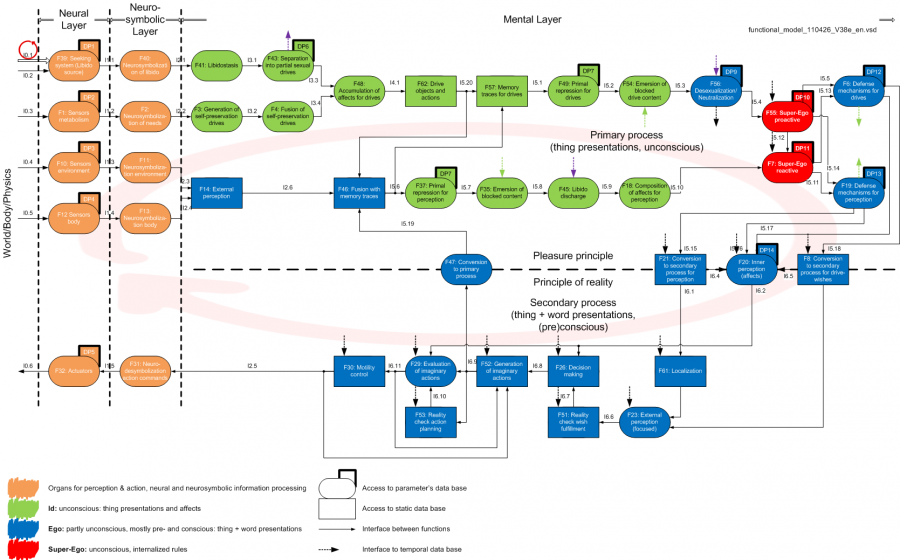Difference between revisions of "ARSModell"
(→Modules) |
|||
| Line 2: | Line 2: | ||
==Modules== | ==Modules== | ||
| + | |||
| + | ===Neural Layer === | ||
*[[F01 – Sensors metabolism]] | *[[F01 – Sensors metabolism]] | ||
| + | *[[F10 – Sensors environment]] | ||
| + | *[[F12 – Sensors body]] | ||
| + | *[[F32 – Actuators]] | ||
| + | *[[F39 – Seeking system (Libido source)]] | ||
| + | |||
| + | |||
| + | |||
| + | === Neurosymbolic Layer=== | ||
*[[F02 – Neurosymbolization of needs]] | *[[F02 – Neurosymbolization of needs]] | ||
| + | *[[F11 – Neurosymbolization environment]] | ||
| + | *[[F13 – Neurosymbolization body]] | ||
| + | *[[F31 – Neuro-desymbolization action commands]] | ||
| + | *[[F40 – Neurosymbolization of libido]] | ||
| + | ===Mental Layer=== | ||
| + | |||
*[[F03 – Generation of self-preservation drives]] | *[[F03 – Generation of self-preservation drives]] | ||
*[[F04 – Fusion of self-preservation drives]] | *[[F04 – Fusion of self-preservation drives]] | ||
| Line 9: | Line 25: | ||
*[[F07 – Super-Ego reactive]] | *[[F07 – Super-Ego reactive]] | ||
*[[F08 – Conversion to secondary process for drive-wishes]] | *[[F08 – Conversion to secondary process for drive-wishes]] | ||
| − | |||
| − | |||
| − | |||
| − | |||
*[[F14 – External perception]] | *[[F14 – External perception]] | ||
*[[F18 – Composition of affects for perception]] | *[[F18 – Composition of affects for perception]] | ||
| Line 22: | Line 34: | ||
*[[F29 – Evaluation of imaginary actions]] | *[[F29 – Evaluation of imaginary actions]] | ||
*[[F30 – Motility control]] | *[[F30 – Motility control]] | ||
| − | |||
| − | |||
*[[F35 – Emersion of blocked content]] | *[[F35 – Emersion of blocked content]] | ||
*[[F37 – Primal repression for perception]] | *[[F37 – Primal repression for perception]] | ||
| − | |||
| − | |||
*[[F41 – Libidostasis]] | *[[F41 – Libidostasis]] | ||
*[[F43 – Separation into partial sexual drives]] | *[[F43 – Separation into partial sexual drives]] | ||
Revision as of 11:29, 25 October 2012
Modules
Neural Layer
- F01 – Sensors metabolism
- F10 – Sensors environment
- F12 – Sensors body
- F32 – Actuators
- F39 – Seeking system (Libido source)
Neurosymbolic Layer
- F02 – Neurosymbolization of needs
- F11 – Neurosymbolization environment
- F13 – Neurosymbolization body
- F31 – Neuro-desymbolization action commands
- F40 – Neurosymbolization of libido
Mental Layer
- F03 – Generation of self-preservation drives
- F04 – Fusion of self-preservation drives
- F06 – Defense mechanisms for drives
- F07 – Super-Ego reactive
- F08 – Conversion to secondary process for drive-wishes
- F14 – External perception
- F18 – Composition of affects for perception
- F19 – Defense mechanisms for perception
- F20 – Inner perception (affects)
- F21 – Conversion to secondary process for perception
- F23 – External perception (focused)
- F26 – Decision making
- F29 – Evaluation of imaginary actions
- F30 – Motility control
- F35 – Emersion of blocked content
- F37 – Primal repression for perception
- F41 – Libidostasis
- F43 – Separation into partial sexual drives
- F45 – Libido discharge
- F46 – Fusion with memory traces
- F47 – Conversion to primary process
- F48 – Accumulation of affects for drives
- F49 – Primal repression for drives
- F51 – Reality check wish fulfillment
- F52 – Generation of imaginary actions
- F53 – Reality check action planning
- F54 – Emersion of blocked drive content
- F55 – Super-Ego proactive
- F56 – Desexualization/Neutralization
- F57 – Memory traces for drives
- F61 – Localization
- F62 – Drive objects and actions
